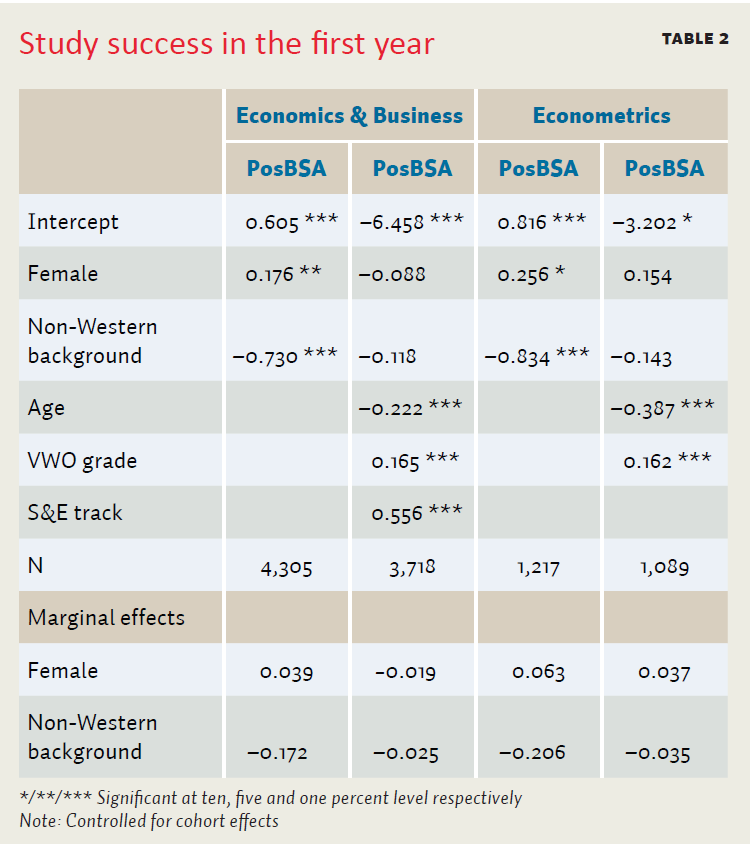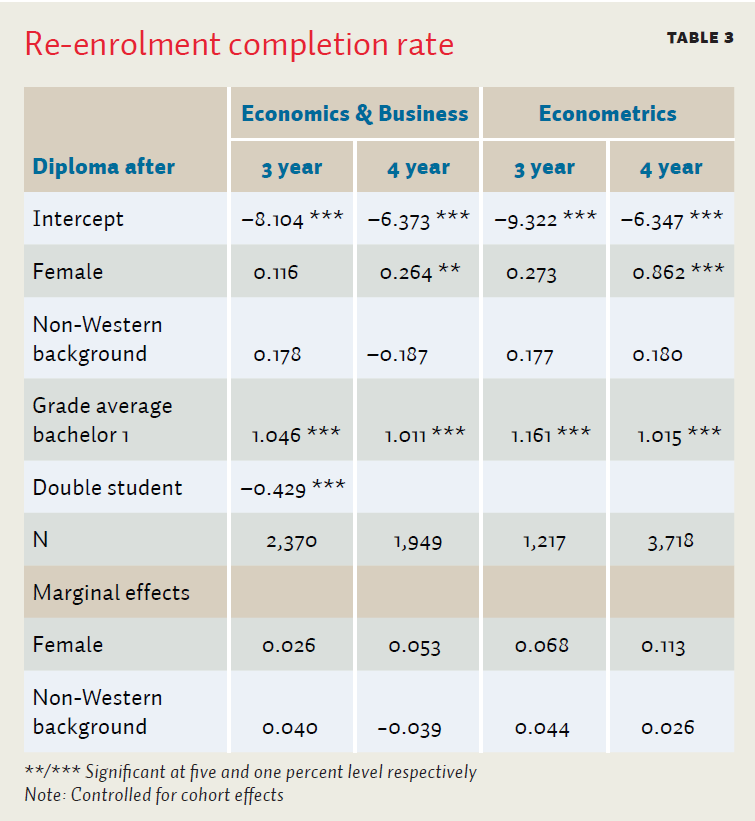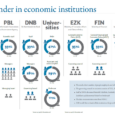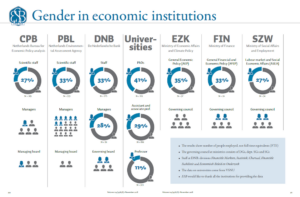It used to be assumed that boys are better at economics than girls. However, today the gender gap in economics education is ancient history. In fact, now female students are the ones performing best in econometrics, the most difficult educational programme in the economics domain.
Women in economics
Why is this article in English?
This article is part of our English publication ‘Women in Economics’. This dossier is in English because English is the main language of the economics and business faculties in the Netherlands, so an ESB dossier about the people who work there should be in English.
This article is also available in Dutch. For the Dutch version click here.
In brief
– The gender gap in economic education is on the decline. Boys no longer are better at economics than girls.
– More girls choose to do econometrics, and here they are performing better than boys.
– Students with a non-Western migrant background have the most transition problems when entering the university.
Economics is known as a diversity-unfriendly discipline. In a recent review article, Bayer and Rouse (2016) confirm that, in the United States, women are still underrepresented among economists. In the Netherlands, it is no different. Data from the Rathenau Institute show that Economics is lagging way behind when it comes to the proportion of women among professors (Rathenau, 2018). At various points along the supply line of economics talent, diversity can be adversely affected. One’s choice of high school track, one’s study choice, study progress within the Economics programmes and (academic) career after graduation – all of these can influence diversity among economists. This article focuses on the chain’s middle section: the flow of female students through the programme. Using data from the Erasmus School of Economics (ESE), I will investigate whether the drop-out rate and the bachelor’s graduation rate are influenced by gender. In passing, I will look at the effect of ethnicity on study performance.
The data pertain to the Dutch-language bachelor’s degree programmes in Economics & Business and in Econometrics & Operations Research, covering the period from 2009 to 2015 (seven cohorts). Over that time, the proportion of women in the Economics programme’s inflow increased slightly from 25.8 percent in 2009 to 28.5 percent in 2015. In the Econometrics programme, the increase was larger, going from 17.9 to 28.5 percent.
Gender gap in economics education
Until recently, in the literature on economics education it was assumed that male students are better at economics than female students. For instance, Ballard and Johnson (2004; 2005) still reported the better study performance of male Economics students in the United States. In the course of time, various explanations have been suggested for this, such as the absence of female role models within the academic staff (McCarty et al., 2006), a comparative male advantage in answering multiple-choice questions (Walstad and Robson, 1997) and the supposedly better mathematical skills that male students have (Lindberg et al., 2010). However, a recent review by Johnson et al. (2014), concludes that the empirical support for a negative gender gap, in which female students perform less well than male students, has attenuated over time.
Background characteristics
Earlier research into study progress in Economics education shows that prior education plays an important role (Allgood et al., 2015). Good results in mathematics courses in secondary education are strongly connected with study success in Economics. Within the Dutch context, subject choice in high school is relevant here. The VWO (pre-university education) track in Science & Engineering (S&E) attracts analytically adept students and offers them a mathematical education, well-suited to economics studies (mathematics B instead of mathematics A, which is usually offered within the Economics & Society track). Earlier, the fact has been established that a science-based track provides a better preparation for studying Economics than the Economics & Society track does, but unfortunately the situation still continues to exist (Arnold, 2010). Another important background characteristic is ethnicity. Students with a non-Western migration background appear to do less well in higher education (Severiens and Wolff, 2008).
Table 1 compares the background characteristics of the ESE students. In addition to the grading average for VWO and the proportion of students with a S&E track, age is also included here. Age provides an indication of the speed with which a student has completed a preparatory education. Repeating a class or a HAVO (higher general secondary education)/VWO trajectory will result in one being a bit older when the bachelor’s programme starts. The greatest difference between male and female entrants has to do with track choice: for men, the S&E track is far more common. This reflects the fact that, within VWO, girls are still underrepresented in this track. Furthermore, female entrants on average have significantly higher VWO grades. In our sample, the age of men and women is comparable. Enrollers with a non-Western migrant background have a lower VWO grade average, have less often chosen to do a S&E track, and enrol at a somewhat higher age. As to the Econometrics programme, the situation is comparable, although the differences between female and male enrollers are smaller.

Study success in the first year
In the first bachelor year, each student receives a binding study advice (BSA). A negative BSA means that a student is not allowed to re-register for the study programme. With a positive BSA, a student can continue the programme. The dummy variable PosBSA takes on the value 1 if the student receives a (conditional) positive BSA, and 0 if the BSA is negative. PosBSA is explained by means of a logistic regression model which includes gender (dummy variable Female), non-Western migration background (dummy variable Non-Western background) and the rest of the background characteristics (the variables Age, VWO grade and the dummy variable S&E track). For the Econometrics programme, the model does not include the S&E track, since mathematics B is an admission requirement. In all estimates, cohort effects are included in order to take into account changes in the education system over time. Table 2 contains the regression results either with or without the variables Age, VWO grade and SE track. Excluding these variables, both programmes show a significant and highly negative effect of ethnicity upon ‘surviving’ the first year. The marginal effects show that, when Non-Western background goes from 0 to 1, the probability of a positive BSA decreases by 0.172 in Economics and 0.206 in Econometrics. As to Female, there is a slightly positive effect. However, as soon as Age, VWO grade and S&E track are included, the significance of Non-Western background and Female disappears and the marginal effects decrease. Gender and ethnicity thus have no significant direct effects upon ‘surviving’ in the first year. The coefficients of VWO grade and (for Economics) S&E track have the predicted positive effect on study success and are very significant. Age, however, is a significantly negative factor. No interaction effects were found among the explanatory variables.

Bachelor graduation rate
After the BSA, the bachelor’s degree is the next formal measuring moment as to study progress. A common measure is the re-enrolment graduation rate after x years. This measures what section of the students who are allowed to continue their studies after the first year, obtained their bachelor’s degree at the end of x years (this is the diploma of the degree programme that students entered in the first year). Again a logistic regression model is used, in which the probability that a degree is obtained after x years is the explanatory variable. In addition to Female and Non-Western background, the grade average in the first bachelor year has been included as an explanatory variable. This variable measures the most recent academic achievement and makes VWO grade, S&E track and Age redundant. There is a considerable group of students combining the economics programme with a law programme. This combination results in study delay. Within the group of double students, however, those with a non-Western migration background are underrepresented. Therefore, for the Economics programme’s three-year graduation rate, a Double student dummy variable was added.
Table 3 summarizes the regression results. It is not surprising that in all regressions the first-year grade average is strongly related to the graduation rate after three or four years. What is striking is that female students have a better four-year graduation rate than their male colleagues do. The effect is particularly marked in Econometrics: for a female re-enroller, the probability of a bachelor’s degree within four years is 0.113 higher than for a male one. And, finally, students with a non-Western migration background do not have a different graduation rate, when we control for double students and the grade average in the first bachelor year.

Conclusions
This article confirms the results of international research that the gender gap in economic education is on the decline. Within the ESE, female students don’t drop out more often in the first year and have a better graduation rate. That women are increasingly interested in econometrics is promising. And they also perform well in this programme. Since many scientists in the economics discipline have an econometric background, this also inspires hope of being able to tackle the academic staff’s lack of diversity. The challenge is now to preserve this up-and-coming female econometric talent for science.
As far as the influence of ethnicity is concerned, the results are less positive. During the first year, the number of students with a non-Western background dropping out from ESE programmes is disproportionally high. This may be explained by their lower VWO-grade average, their higher age, and the small number of pupils with a S&E track. When correcting for this, there is no longer a negative ethnicity effect on drop-out. This does not mean that there is no problem. Students with a non-Western migrant background face transition problems when they move from VWO to ESE programmes. This emphasizes the importance of a better awareness of and preparation for the analytical nature of these programmes.
References
Allgood, S., W.B. Walstad and J.J. Siegfried (2015) Research on teaching economics to undergraduates. Journal of Economic Literature, 53(2), 285–325.
Arnold, I.J.M. (2010) Het failliet van een VWO-profiel. ESB, 95(4583), 253.
Ballard, C. and M.F. Johnson (2004) Basic math skills and performance in an introductory economics class. The Journal of Economic Education, 35(1), 3–23.
Ballard, C. and M.F. Johnson (2005) Gender, expectations, and grades in introductory microeconomics at a US university. Feminist Economics, 11(1), 95–122.
Bayer, A. and C.E. Rouse (2016) Diversity in the economics profession: a new attack on an old problem. Journal of Economic Perspectives, 30(4), 221–242.
Johnson, M., D. Robson and S. Taengnoi (2014) A meta-analysis of the gender gap in performance in collegiate economics courses. Review of Social Economy, 72(4), 436–459.
Lindberg, S.M., J.S. Hyde and J.L. Petersen (2010) New trends in gender and mathematics performance: a meta-analysis. Psychological Bulletin, 136(6), 1123–1135.
McCarty, C., G. Padgham and D. Bennett (2006) Determinants of student achievement in principles of economics. Journal for Economic Educators, 6(2), 1–9.
Rathenau (2018) Het aandeel vrouwelijke hoogleraren in Nederland en EU-landen. Indicator Rathenau Instituut. Available at www.rathenau.nl.
Severiens, S. and R. Wolff (2008) A comparison of ethnic minority and majority students: social and academic integration, and quality of learning. Studies in Higher Education, 33(3), 253–266.
Walstad, W.B. and D. Robson (1997) Differential item functioning and male-female differences on multiple-choice tests in economics. The Journal of Economic Education, 28(2), 155–171.
Auteur
Categorieën









